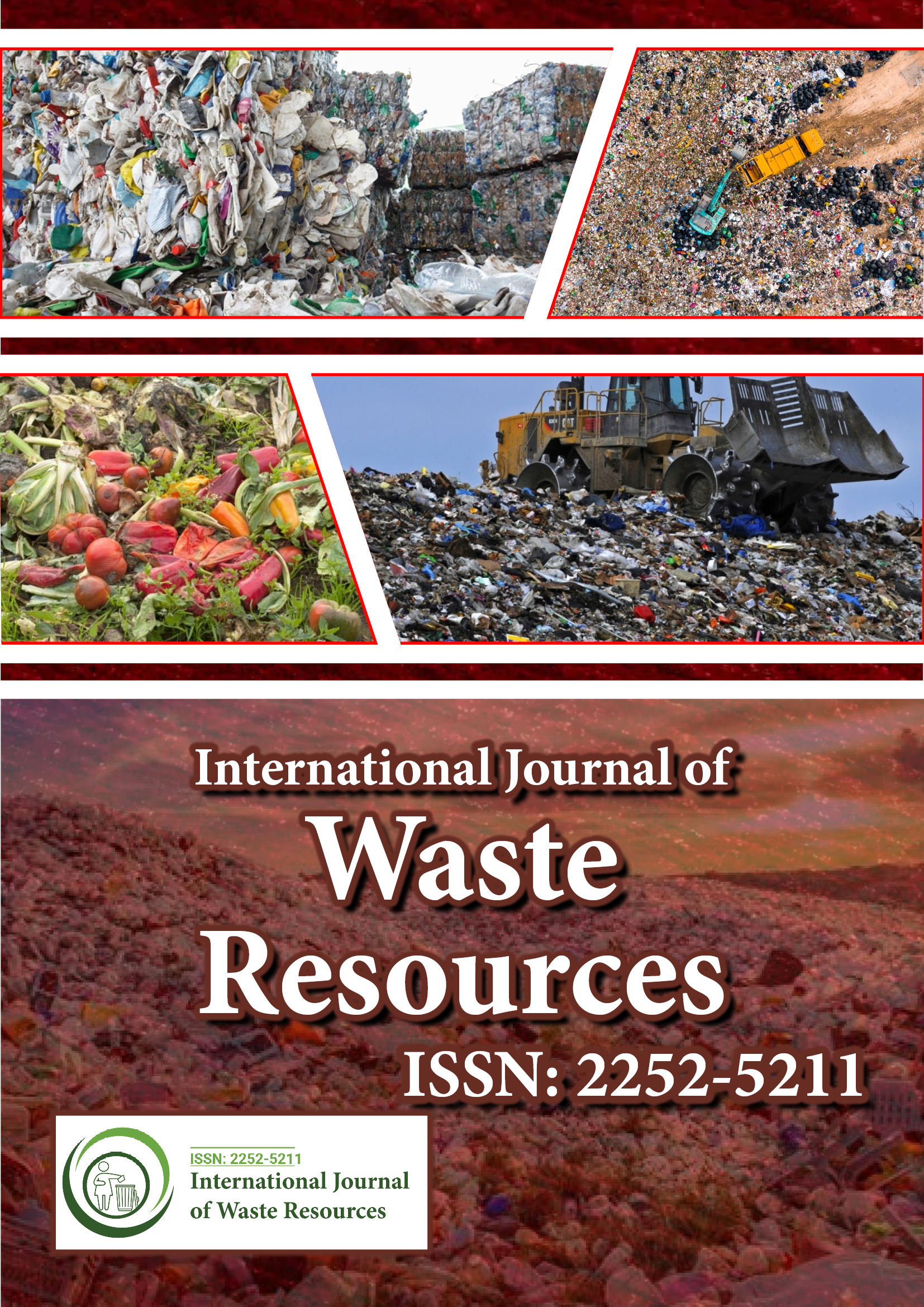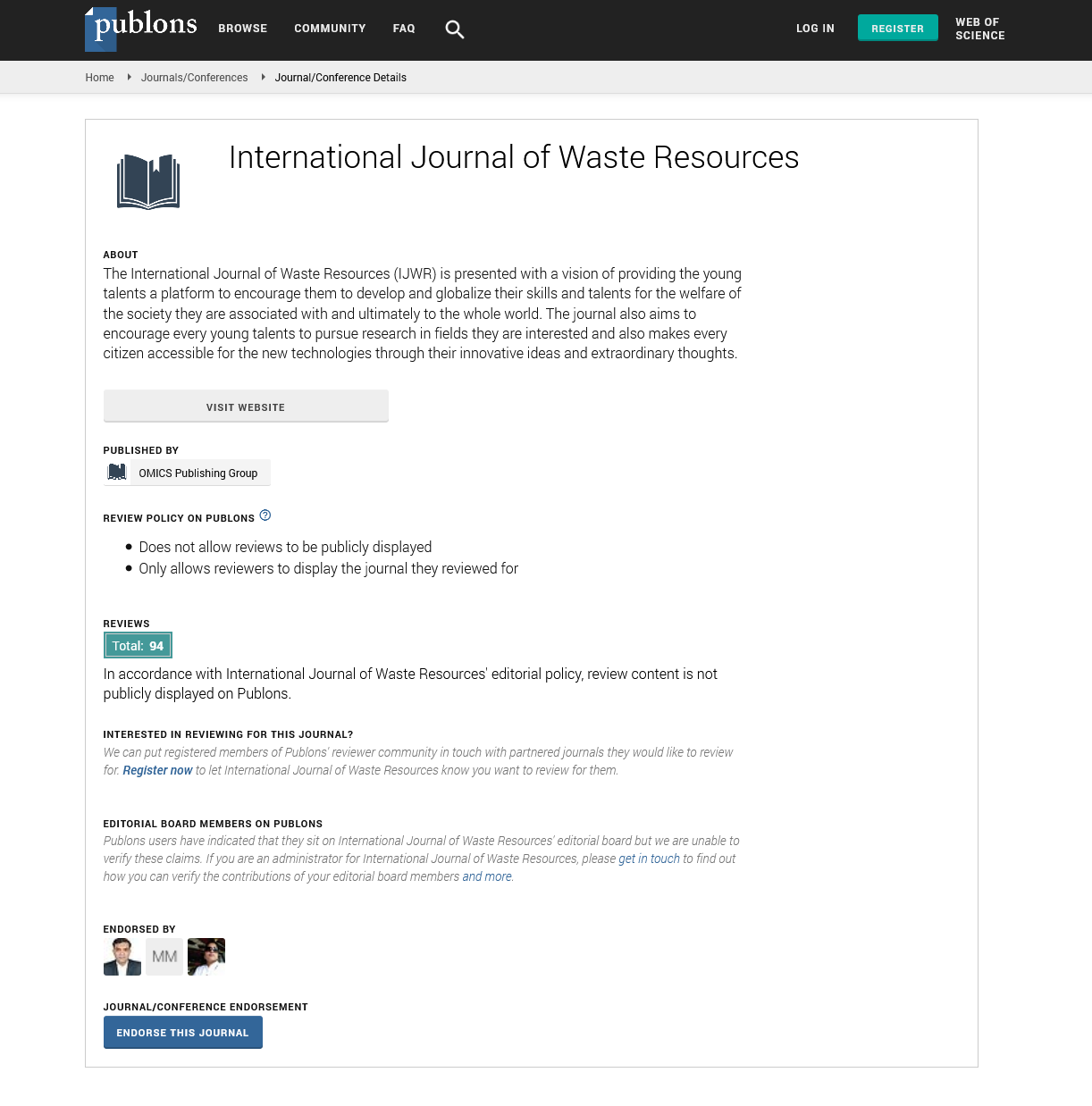Indexed In
- Open J Gate
- The Global Impact Factor (GIF)
- Open Archive Initiative
- VieSearch
- International Society of Universal Research in Sciences
- China National Knowledge Infrastructure (CNKI)
- CiteFactor
- Scimago
- Ulrich's Periodicals Directory
- Electronic Journals Library
- RefSeek
- Directory of Research Journal Indexing (DRJI)
- Hamdard University
- EBSCO A-Z
- Publons
- Google Scholar
Useful Links
Share This Page
Journal Flyer

Open Access Journals
- Agri and Aquaculture
- Biochemistry
- Bioinformatics & Systems Biology
- Business & Management
- Chemistry
- Clinical Sciences
- Engineering
- Food & Nutrition
- General Science
- Genetics & Molecular Biology
- Immunology & Microbiology
- Medical Sciences
- Neuroscience & Psychology
- Nursing & Health Care
- Pharmaceutical Sciences
Short Communication - (2025) Volume 15, Issue 2
General Waste Management: Principles, Challenges, Strategies, Environmental Impact, and Sustainable Solutions
Keerthana Kumar*Received: 30-Apr-2025, Manuscript No. IJWR-25-29427; Editor assigned: 02-May-2025, Pre QC No. IJWR-25-29427; Reviewed: 16-May-2025, QC No. IJWR-25-29427; Revised: 23-May-2025, Manuscript No. IJWR-25-29427; Published: 30-May-2025, DOI: 10.35248/2252-5211.25.15.610
Description
General waste management refers to the collection, transportation, processing, recycling and disposal of everyday waste produced by households, businesses, institutions and industries. It is a crucial component of public health, environmental protection and sustainable development. The growing volume of waste generated globally due to urbanization, population growth and industrialization presents significant challenges for communities and governments, requiring efficient and environmentally responsible solutions.
Waste is commonly categorized into several types, including municipal solid waste, industrial waste, hazardous waste and biomedical waste. General or municipal solid waste includes everyday items such as food scraps, packaging materials, plastics, paper, glass, metals and textiles. Managing this type of waste involves a coordinated system that prevents pollution, protects ecosystems and conserves natural resources [1].
The primary goals of waste management are to reduce waste generation, reuse materials where possible, recycle resources, recover energy and ensure safe disposal. This hierarchy often referred to as the "5 R's" (Reduce, Reuse, Recycle, Recover and Residual management) guides decision-making to minimize environmental impact. Reducing waste at the source, such as through sustainable product design or reduced consumption, is the most effective approach. Reusing items extends their life and decreases the need for new production. Recycling transforms waste into new products, conserving raw materials and energy [2,3].
Despite these principles, many regions still rely heavily on landfilling and open dumping, practices that pose serious environmental and health risks. Landfills, though regulated in some countries, can lead to soil and groundwater contamination through leachate, emit methane (a potent greenhouse gas) and create unpleasant odors and visual blight. Open dumping, which is unregulated disposal, contributes to air and water pollution, spreads disease and endangers wildlife [4].
Incineration, another common waste disposal method, reduces waste volume significantly and can generate energy. However, it also raises concerns about air pollution, toxic ash and high operational costs. Modern incinerators are equipped with emission control technologies, but public resistance remains strong in many areas due to historical issues with harmful emissions like dioxins and furans [5].
Recycling programs vary widely in effectiveness depending on infrastructure, public participation, market demand for recycled materials and policy support. Successful recycling systems require proper segregation at the source, efficient collection systems, processing facilities and end-use markets. Contamination of recyclables is a major issue, as mixed or improperly sorted waste can render large volumes unsuitable for recycling. Education and awareness campaigns play an essential role in improving public understanding and participation in recycling efforts [6].
Composting is another sustainable method of managing organic waste such as food scraps, garden clippings and agricultural residues. By allowing organic materials to decompose under controlled conditions, composting produces nutrient-rich soil amendments that improve soil health and reduce the need for chemical fertilizers. Community composting programs, home composting bins and industrial-scale composting facilities all contribute to diverting organic waste from landfills [7].
Modern waste management strategies increasingly focus on integrated approaches that combine multiple methods tailored to local conditions. For example, cities may adopt a combination of recycling, composting, incineration and sanitary landfilling, supported by regulations, economic incentives and public education. Technologies such as Waste-To-Energy (WTE), anaerobic digestion and advanced material recovery facilities offer promising ways to improve efficiency and reduce environmental impacts [8].
Economic considerations play a significant role in shaping waste management systems. The costs of collection, transport, treatment and disposal must be balanced with available funding, often through public budgets, service fees, or private partnerships. In many developing countries, waste management systems are underfunded or poorly maintained, leading to inadequate services and environmental degradation. Informal waste pickers in these regions play a crucial role in recycling and resource recovery, though often under unsafe and unregulated conditions [9].
Government policies, regulations and international agreements have a major influence on waste management practices. Regulations may set standards for waste treatment, restrict certain materials, require producer responsibility, or incentivize recycling and reuse. Extended Producer Responsibility (EPR) programs, for example, require manufacturers to manage the end-of-life of their products, encouraging design improvements and reducing the burden on municipal systems.
Public participation is fundamental to the success of any waste management program. People must be informed, motivated and provided with the tools to separate waste correctly and reduce overall waste generation. Community engagement, school programs and media campaigns can foster a culture of environmental responsibility and collective action [10].
In recent years, the concept of a circular economy has gained momentum as an alternative to the traditional linear model of "take-make-dispose." A circular economy aims to design waste out of the system, keeping materials in use for as long as possible through reuse, repair, remanufacturing and recycling. Waste becomes a resource rather than a problem, supporting both environmental sustainability and economic development.
Conclusion
In conclusion, general waste management is a complex but essential service that impacts environmental quality, public health and sustainable growth. It requires a coordinated effort among governments, businesses, communities and individuals to implement practical, cost-effective and environmentally sound solutions. As waste volumes continue to rise, innovative technologies, supportive policies and public engagement will be key to building resilient waste management systems and achieving long-term sustainability.
References
- Ma S, Li H, Fei J, Huang Q. Robust micro-nano hybrid aerogel derived from waste resources for thermal management and high-efficiency adsorption. Chem Eng J. 2024;486:150223.
- Landrigan PJ, Fuller R. Global health and environmental pollution. Int J Public Health. 2015;60(7):761-2.
[Crossref] [Google Scholar] [PubMed]
- Yuan Y, Lin J, Wang X, Qian J, Zuo P, Zhuang Q. Achieving excellent dielectric and energy storage performance in core-double-shell-structured polyetherimide nanocomposites. Polymers. 2023;15(14):3088.
[Crossref] [Google Scholar] [PubMed]
- Shimizu T, Kanamori K, Nakanishi K. Siliconeâ?based organic–inorganic hybrid aerogels and xerogels. Chemistry. 2017;23(22):5176-5187.
[Crossref] [Google Scholar] [PubMed]
- Majumder D, Fajal S, Shirolkar MM, Torris A, Banyla Y, Biswas K, et al. Nanoâ?springe enriched hierarchical porous MOP/COF hybrid aerogel: Efficient recovery of gold from electronic waste. Angew Chem Int Ed Engl. 2024;e202419830.
[Crossref] [Google Scholar] [PubMed]
- Geng G, Gao Y, Zhang Z, Gao K, Zhang W, Song J. Renewable and robust biomass waste-derived Co-doped carbon aerogels for PMS activation: catalytic mechanisms and phytotoxicity assessment. Ecotoxicol Environ Saf. 2021;220:112381.
[Crossref] [Google Scholar] [PubMed]
- Liu Z, Ran Y, Xi J, Wang J. Polymeric hybrid aerogels and their biomedical applications. Soft Matter. 2020;16(40):9160-75.
[Crossref] [Google Scholar] [PubMed]
- Huang T, Long Y, Dong Z, Hua Q, Niu J, Dai X, et al. Ultralight, elastic, hybrid aerogel for flexible/wearable piezoresistive sensor and solid-solid/gas-solid coupled triboelectric nanogenerator. Adv Sci (Weinh). 2022;9(34):e2204519.
[Crossref] [Google Scholar] [PubMed]
- Annu, Park SS, Alam MN, Yewale M, Shin DK. Unraveling the electrochemical insights of cobalt oxide/conducting polymer hybrid materials for supercapacitor, battery and supercapattery applications. Polymers. 2024;16(20):2907.
[Crossref] [Google Scholar] [PubMed]
- Shrestha LK, Shrestha RG, Shahi S, Gnawali CL, Adhikari MP, Bhadra BN, Ariga K. Biomass nanoarchitectonics for supercapacitor applications. J Oleo Sci. 2023;72(1):11-32.
[Crossref] [Google Scholar] [PubMed]
Citation: Kumar K (2025) General Waste Management: Principles, Challenges, Strategies, Environmental Impact and Sustainable Solutions. Int J Waste Resour: 15:610.
Copyright: © 2025 Kumar K. This is an open-access article distributed under the terms of the Creative Commons Attribution License, which permits unrestricted use, distribution and reproduction in any medium, provided the original author and source are credited.

